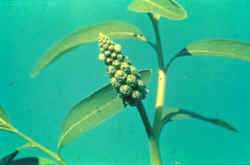Gooseweed
Scientific name:
Sphenoclea zeylanica
Synonym: Chickenspike
 Photo courtesy of IRRI and University of Queensland
Photo courtesy of IRRI and University of Queensland
Habitat
Irrigated rice fields, swamps, and stagnant waters
Affected crops
Mostly irrigated rice
Description
The stem is erect, branched, smooth, and hollow. The leaves are smooth and spoon-shaped and grow opposite each other. The flower head is a distinctive cylindrical crowded terminal spike that bears whitish to greenish flowers. The roots are long and have cord-like appearance. The plant has a fleshy appearance. It is propagated by seeds.
n
Effects and impacts
Gooseweed competes with rice for soil nutrients and sunlight. It can lower the yield by up to 50% when left uncontrolled (Rice IPM, 2001).
The young plants and leaves are eaten as vegetables.
Studies show that the weed is found resistant to 2,4-D on some rice fields in Malaysia, Thailand, and the Philippines (Weed Science, 2005).
Methods of control
- Proper seed selection
- Thorough land preparation by plowing and harrowing
- Rice seedbeds should be free of weeds
- Regular plant monitoring
- Proper water and fertilizer management
- Closer plant spacing to prevent the germinating seeds of the weeds being exposed to sunlight
- Hand weeding
- Crop rotation

